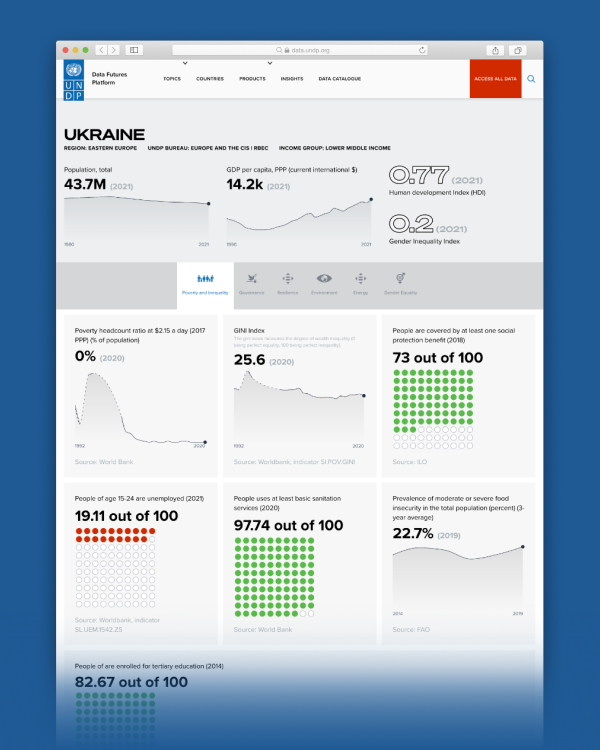



Image Credit : United Nations Development Programme

Project Overview
The United Nations Development Programme (UNDP) is the UN's global development network, advocating for change and connecting countries to knowledge, experience and resources to help people build a better life. The Data Futures Platform (DFP) launched in December 2020 is one of the first efforts to reduce the silo by translating multidimensional data into actionable and evidence-based insights that foster system thinking and co-creation of policy initiatives. By democratizing knowledge and breaking down barriers to information access, and with the aim to capture patterns, the DFP offers the ability to host data, analyses, tools and the ability to amplify findings, best practices, and solutions built for scale. It was designed to help practitioners and decision-makers analyze complex issues and assess the potential impacts of different combinations of policy choices through credible and disaggregated data.
Organisation
United Nations Development Programme
Team
Babatunde Abidoye - Global Policy Advisor
Mustafa Saifee - Data Visualization Specialist
Andrey Krachkov - Data Analyst
Kieran Glover - UX/UI Designer
Emanuele Fara - Product Manager & Developer
Project Brief
The DFP, previously the COVID-19 Data Futures Platform, was to be understood as an enabler to UNDP’s response to COVID-19 recognizing that the effective use of data is a critical and cross-cutting enabler for the technical response to COVID-19. While COVID-19 provided the opportunity to set up the DFP, the needs and value remain. For the purpose of relevancy and to reflect an ever-changing world, a redesign of the platform became paramount. Leveraging expertise in data analysis, data science, integrated policy and data engineering, and in close collaboration with multidisciplinary teams, it entailed:
• Expanding the scope of the DFP beyond COVID-19 to align with international strategic plans and priorities, including the 2030 Agenda for Sustainable Development
• Ensuring offerings respond to concrete demands in particular at regional and country levels
• Improving both user interface design and user experience, including optimizing for search engine visibility
Project Need
Necessary changes identified respond to the need for better evidence-based decision-making and greater impact on the ground while tackling the challenge of integrating datasets coming from diverse sources in an easy and timely manner. Building on the revised version of the DFP, stakeholders ranging from development partners, governments, academia, and the private sector gain the ability to:
• Easily explore tailored data insights and ready-made analyses covering a wide range of thematic areas with a look at the global, regional, national, and sub-national levels.
• Bring complex data together and overlay datasets in a way that is powerful and intuitive, even for non-technical users thanks to interactive visualizations highlighting the developments on the key indicators used to track the progress.
• Access comprehensive country profiles providing full time-series breakdowns for each development-related indicator available while supporting further options for exploring correlations between indicators, country ranks, and trends for more customizable analyses.
User Experience
The DFP can now boast of being the broker between this ever-expanding wealth of information and activities on the ground confronting all available data with necessary technical expertise. The platform features a wide range of data related to topics such as poverty, gender equality, environment, energy, governance and resilience. Users can access data at global, national, and sub-national levels and download data in various formats.
UI/UX Features include:
• Clarity and simplicity: The website is easy to navigate, even for users. All the content and data on the website are tagged and searchable based on different thematic areas.
• Visualization: Dynamic data visualizations are used to present complex information in a clear and understandable way. Charts and graphs help users quickly understand the key trends and patterns in the data.
• Explore multiple variables: Exploratory, interactive visualizations allow users to discover relationships between multiple variables simultaneously, providing a more comprehensive understanding of the data.
• Drive hypothesis generation: Tools on the DFP help users generate new hypotheses and insights, by exploring data in different ways and in different charts and visualizations. Users may discover unexpected patterns or relationships that lead to new insights.
Project Marketing
The DFP is close to having generated 1M page views since inception thanks to approximately 160 000 users. This is the result of continuous efforts invested in promotion and partnership activities. The platform has been used as a touchpoint for many articles and analyses and cited by non-profits as a data source. The revised version of the platform is expected to draw even more attention.
Project Privacy
The DFP is an open resource. The knowledge generated and showcased is also made accessible to external stakeholders, including governments, the private sector and academia, for better coherency and harmonization in global efforts towards the achievement of the SDGs.
Digital - Community
This category is all about helping our communities to connect and engage, from emergency services to Not for Profits to social groups, these apps and sites not may not only assist in delivery but also create efficiencies providing those at the coalface more time to do their important work whether it be fighting fires or managing the local team. It's not all serious though we're also looking for projects that work to help bring the community groups together with fun and enjoyable activities.
More Details

